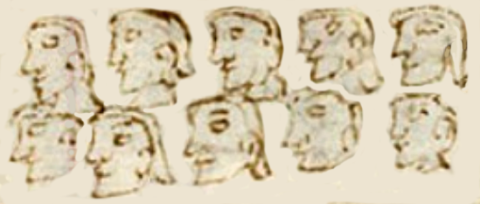matlactli tlaca (CST44)
This painting of the simplex glyph for the term matlactli tlaca (“ten people”) shows two horizontal rows of five men’s heads per row (a count seemingly originating with counting with fingers), all looking toward the viewer’s left. While some color appears in this image, the faces on the original manuscript are not purposely colored. (We removed the background color to make the heads more visible.)
Stephanie Wood
These men were employed to guard the silk produced in Santa Catalina Texupan as it was carried to Mexico City. Each guard earned 10 pesos, for a total cost to the town of 100 pesos, as shown in the contextualizing image. The tlacuilo had the option of putting a notation for ten next to the head of one man, but he chose to draw ten heads, instead. The notation ten was often ten small circles, but in Huexotzinco codices it can be a wide diamond shape (see below). For more on the Codex Sierra, see Kevin Terraciano’s study (2021).
Stephanie Wood
1550–1564
Jeff Haskett-Wood
cabezas, diez, mahtlactli, hombres, trabajadores, guardas, guardar, proteger, número, números, trabajo, seda, silk

matlac(tli), ten, https://nahuatl.wired-humanities.org/content/matlactli
tlaca(tl), person (in the plural: tlaca, people), https://nahuatl.wired-humanities.org/content/tlacatl
diez hombres
Stephanie Wood
Códice Sierra-Texupan, plate 44, page dated 1561. Origin: Santa Catalina Texupan, Mixteca Alta, State of Oaxaca. Kevin Terraciano has published an outstanding study of this manuscript (Codex Sierra, 2021), and in his book he refers to alphabetic and “pictorial” writing, not hieroglyphic writing. We are still counting some of the imagery from this source as hieroglyphic writing, but we are also including examples of “iconography” where the images verge on European style illustrations or scenes showing activities. We have this iconography category so that such images can be fruitfully compared with hieroglyphs. Hieroglyphic writing was evolving as a result of the influence of European illustrations, and even alphabetic writing impacted it.
https://bidilaf.buap.mx/objeto.xql?id=48281&busqueda=Texupan&action=search
The Biblioteca Digital Lafragua of the Biblioteca Histórica José María Lafragua in Puebla, Mexico, publishes this Códice Sierra-Texupan, 1550–1564 (62pp., 30.7 x 21.8 cm.), referring to it as being in the “Public Domain.” This image is published here under a Creative Commons license, asking that you cite the Biblioteca Digital Lafragua and this Visual Lexicon of Aztec Hieroglyphs.







